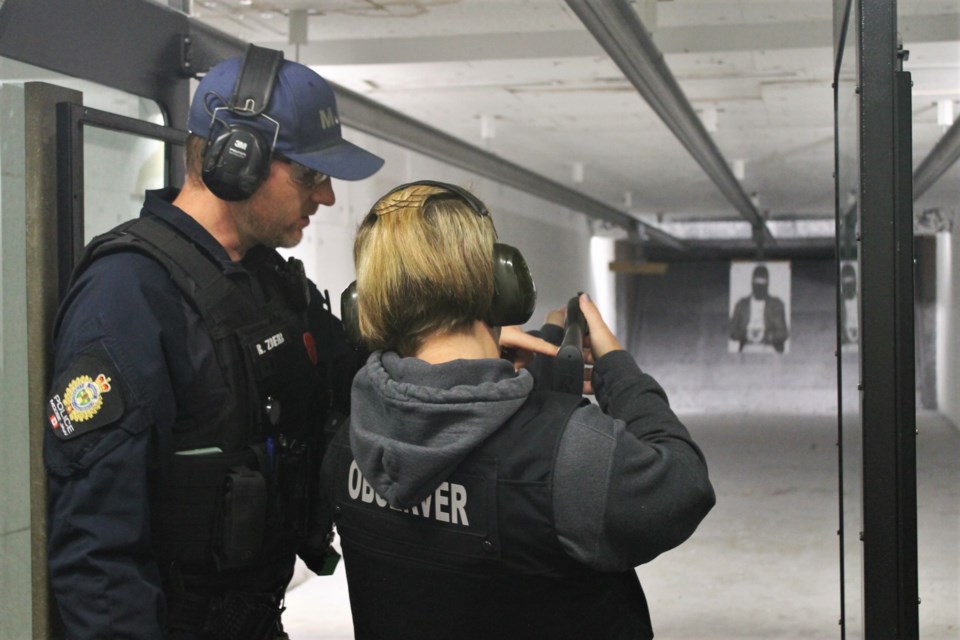Cst. Rod Zoerb and Cst. Mel Ziffle with the Moose Jaw Police Service are just two members certified to facilitate firearms training sessions for MJPS officers, and they shared a rundown of the weapons that MJPS members are trained to use on the ground.
MJPS members have access to a handful of different weapons, all of which they are authorized to use in situations that call for a higher level use of force response.
In addition to a taser and baton, MJPS officers carry a pistol, kept in a holster on their person at all times. The standard issue sidearm currently in use is a generation four Glock pistol, which uses 40 calibre rounds in a 15-round magazine.
All officers carry three magazines at all times — one loaded in the pistol, and two additional on their belt. Their sidearm always has a bullet loaded in the chamber while on duty, for a total of 46 rounds on their person.
All members must fire a minimum of 30 rounds with their sidearm each year, all of which must land in the centre mass zone of the standard-issue target, in order to remain certified to carry a sidearm.
Officers often spend their own time in the range training for this, and the MJPS went through about 30,000 practice rounds last year — bullets used during target practice and drills as they are cheaper than the duty rounds used during regular patrol.
MJPS members also undergo other tactical training regularly, such as building-clearing exercises, pistol manipulation drills, and taser practice.
Sidearm safety measures are priority
The model 22 Glock features a built-in safety system, comprised of three different mechanisms that prevent the sidearm from firing unless there is a deliberate pull of the trigger.
According to the manufacturer, the safety system is meant to make accidental firing nearly impossible.
“[Glock] claims you can take the gun, load it, throw it off a three-story building or do whatever you need it to do, and it will never accidentally go off,” said Zoerb. “The only thing that can defeat [those safeties] is an intentional trigger pull."
For this reason, MJPS officers follow a very strict “trigger rule,” unique to policing, to avoid accidental gunshots — the index finger remains outside of the trigger guard until the decision to fire is absolute. Every trigger pull has to be a deliberate decision.
Because officers often find themselves in tense situations, both the safeties and the trigger rule are paramount. They avoid accidental misfires during physical altercations, as well as startled responses or instinctual grip responses in the hands.
There are a number of firearm rules ingrained in MJPS officers, beginning during range practice, that are meant to be carried into the field with them — the trigger rule, as well as the policy of treating every firearm as if it is loaded and never pointing the muzzle of a gun at something you aren’t willing to destroy.
“What we want is for them to know [these rules] by heart and consider these whenever they're going to operate with their pistols out or use their firearms,” said Zoerb.
Utilizing longer-range weapons for safety
Patrol officers also carry a standard-issue Remington 870 12-gauge shotgun in their patrol vehicles, and a handful of specially trained officers operate a Colt C8, a semi-automatic carbine rifle for longer-range situations.
For the most part, the Glock is a short-range weapon, said Zoerb. With a range of less than 20 yards, the sidearm is not meant to be accurate at a distance.
“This gun was built for close-quarter battle, that's why it has the capacity to carry a lot of rounds — so you can spit a lot of rounds very quickly,” said Zoerb.
To address this issue, officers carry longer-range weapons, like the pump-action shotgun which has a range of about 50 yards and the carbine rifle which is very accurate at much longer distances.
“[The carbine] extended our range at gun calls, to perimeters where we can be across the street, behind a car, or behind cement retaining walls, and we can still reach out and interact with a person,” said Zoerb.
Extending distance and range increases safety for officers, and creates more time to handle a situation. All officers wear body armour that is able to stop handgun rounds, but it’s not infallible.
Officers are able to insert trauma plates into their body armour, which are steel plates that help protect against higher velocity bullets, like shotgun or carbine rounds.
Trauma plates are useful but greatly increase the weight of a vest, which already averages about 30 pounds with all of the gear an officer carries.
Firearms training is a portion of fieldwork that MJPS officers spend a lot of time on, although it can be tough in between the many other regular patrol duties on an officer’s plate.
“It's hard to find time to do this every week. There's so much more stuff that we do as police officers, patrol people especially,” said Ziffle.
Preparedness is important, said both constables, because handling a firearm is a serious situation that requires the appropriate proficiency to make those decisions.
It’s an MJPS policy to release a statement every time an officer utilizes any of their weapons, and while it hasn’t been an often occurrence lately, the MJPS continuously takes training seriously to better prepare all members on duty.
Details for this article were collected as part of the Moose Jaw Express’s attendance at the Community Police Academy.




